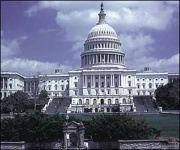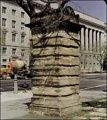Difference between revisions of "Aquia Creek sandstone"
Jump to navigation
Jump to search
(username removed) |
(username removed) |
||
| Line 16: | Line 16: | ||
* ''Dictionary of Building Preservation'', Ward Bucher, ed., John Wiley & Sons, Inc., New York City, 1996 | * ''Dictionary of Building Preservation'', Ward Bucher, ed., John Wiley & Sons, Inc., New York City, 1996 | ||
| − | * | + | * Frank A. Lent, ''Trade names and Descriptions of Marbles, Limestones, Sandstones, Granites and Other Building Stones Quarried in the United States Canada and other Countries.'', Stone Publishing Co, New York, 1925 |
[[Category:Materials database]] | [[Category:Materials database]] | ||
Revision as of 06:26, 24 July 2013
Description
A fine-grain sandstone cemented with large chunks of clay quarried in Stafford County, Virginia. Aquia Creek sandstone comes in many pale colors such as light gray, pink, buff and beige. Although a popular construction stone in Washington DC from 1790 to 1840, Aquia Creek sandstone was poorly cemented. It was used in the rotunda of the U.S. Capitol, but, because of flaws, much of it was painted or replaced soon after it was installed.
Additional Images
Authority
- Dictionary of Building Preservation, Ward Bucher, ed., John Wiley & Sons, Inc., New York City, 1996
- Frank A. Lent, Trade names and Descriptions of Marbles, Limestones, Sandstones, Granites and Other Building Stones Quarried in the United States Canada and other Countries., Stone Publishing Co, New York, 1925


